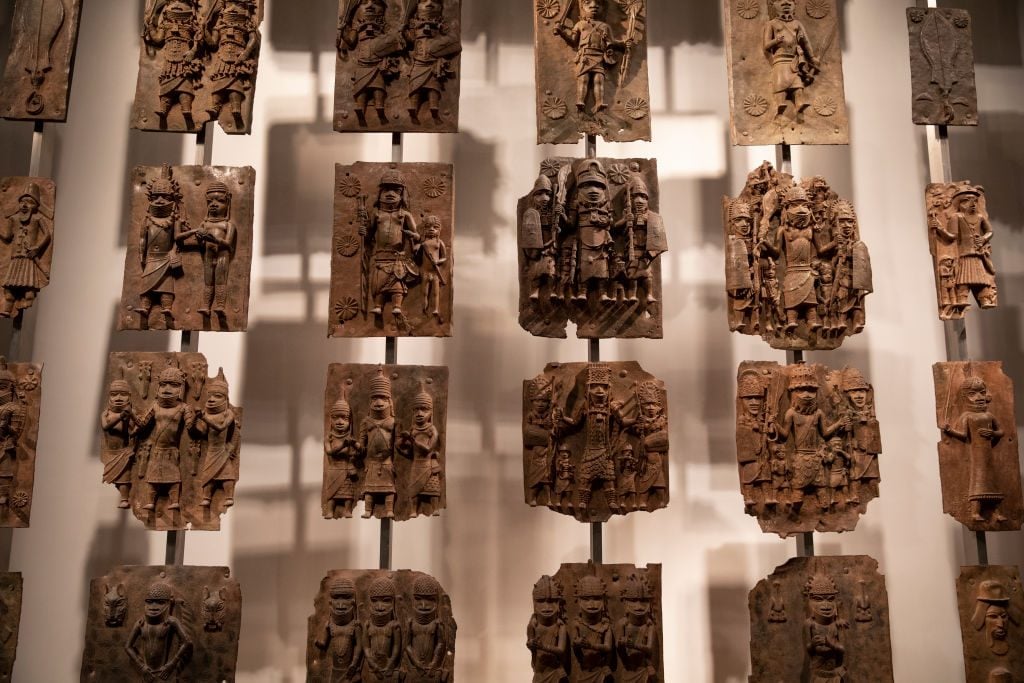After many decades of inaction, many museums in the West have been forced to recognize that tucked into their storage facilities are a stunning array of wonders that were forcibly taken from the Benin Royal Palace in 1897 by the British on a so-called punitive expedition.
And now, finally, changes seem to be underway.
After the publication of a groundbreaking report in France by Felwine Sarr and Benedicte Savoy advising President Emmanuel Macron to return the Benin Bronzes in national collections, a portal opened, catalyzing other European nations to do the same. Suddenly, after so much silence, restitution finally seems like a real possibility.
Germany, which has some of the largest collections of the Benin bronzes after the U.K., announced last month it would begin returns in 2022. It is likely that many of the work will end up in the David Adjaye-designed Edo Museum of West African Art after it opens in 2025.
To better understand this critical turning point, Artnet News brought together three key figures for a conversation about the restitution of the Benin bronzes: Victor Ehikhamenor, a Lagos-based artist and trustee of the Legacy Restoration Trust, an organization working on the Benin bronzes’ return; Pitt Rivers Museum curator Dan Hicks, author of The Brutish Museums; and Marla Berns, director of the Fowler Museum in Los Angeles.
Here’s what they told us.
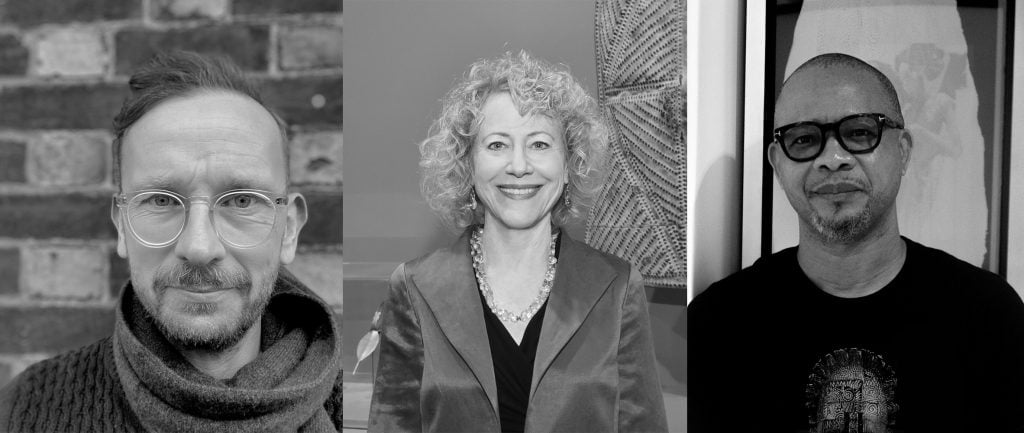
From left, Dan Hicks, Marla Berns, and Victor Ehikhamenor.
Victor, you came to know about this art as a young person. What does the Edo Museum of West African Art (EMOWAA) mean, and how can it show these objects in a way that other museums cannot?
Victor Ehikhamenor: The EMOWAA museum is many things. I realized through recent conversations that some only consider that its being built because we expect the Benin Bronzes to be returned. We are forgetting that after 1897, creativity did not stop. Benin has always been a kingdom that innovates and builds. The Western narrative is that there is no history if it has not been told by a Western historian. But there are questions for the whole of sub-Saharan [Africa] too: how did our artworks reference each other? How did we feed off each other creatively?
We are building this museum for many reasons. Its absence has become an excuse for some people who don’t want to return the stolen items. “Where are you going to put them?” they ask. These people forget that they were not stolen from a museum. These objects were taken from a particular place where they were meant to be.
The punitive expedition and the reality of colonialism has largely been omitted from education in the Global North. How is this history addressed in your educational systems?
VE: It is not something that is present. We knew that the kingdom was attacked, burned down, and rebuilt. We knew that we didn’t have an oba [hereditary ruler] for 14 years while the British were trying to skew things. Those are all oral narratives. As a young student, we studied the empires: the Ghana empire, the Yoyo empire. The education we were fed was also a colonial education. Certain facts were omitted. We can even go back to the language of a “punitive exhibition.” What is a “punitive expedition”? I know that Dan [Hicks] has also questioned that. Language and education were part of the tools of colonialism.
Dan Hicks: What I learned in writing [The Brutish Museums], which was a shock, in some ways, was how many of these “punitive expeditions” were undertaken. At the time, the so-called Little Wars that the Victorians wrote about were immense military interventions. Yet they describe them as individual events. They did not underline how connected these events were after the Berlin Conference of 1884 [in which European powers partitioned Africa], which is a sort of ground zero for this history. In what is now Nigeria, Kenya, South Africa, Uganda, Sudan, there was the removal of chiefs, kings, or obas who outlived their usefulness and who were getting in the way of an increasingly aggressive and capitalist corporate colonialism. This was happening in a so-called “protectorate.” The language of the protectorate is the language of the mafia. “We’re going to protect you—or else.” So the language of the “punitive expedition” defines these attacks as a punishment. Whether in the case of the Benin attack, or in the case of a whole host of other attacks, the notion is about reprisal, and that there is some earlier act that justified this ultraviolence.
This happens for restitution conversations now as well. The idea is that those who want restitution are attacking museums. We have to understand how the logic of late Victorian colonialism continues into the present.
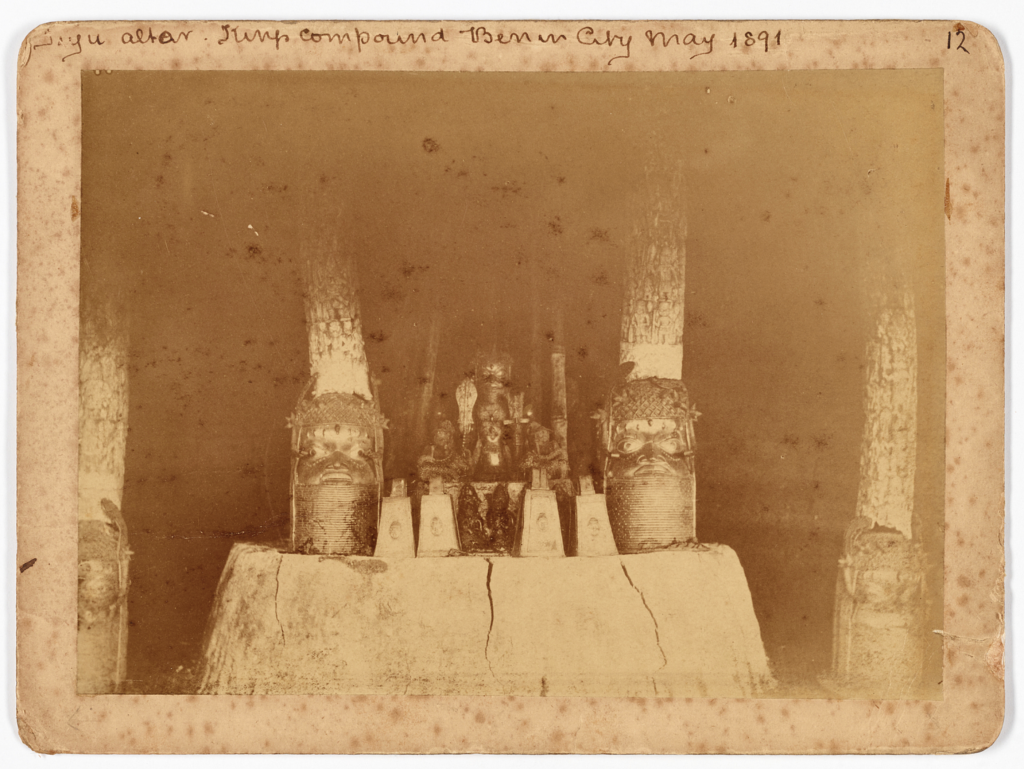
Photograph of an ancestral shrine at the Royal Palace, Benin City taken during the visit of Cyril Punch in 1891. Eliot Elisofon Photographic Archives, National Museum of African Art, Smithsonian Institution. EEPA.1993-014.
Marla, can you speak about what you have been doing at your institution?
Marla Berns: Just two years after the Fowler Museum was established in 1963, through a kind of serendipitous meeting, the chancellor of UCLA and a member of the Wellcome Trust had a conversation about how much money it cost to store this phenomenal collection that Sir Henry Wellcome had amassed around the turn of the 20th-century. There were dispersals of this vast collection—especially the ethnographic component of it—after World War II, and a lot of work went to the British Museum and the Pitt Rivers Museum.
In 1965, we received 30,000 objects from that collection in one fell swoop, sent by ship to this fledgling museum. Among those objects are about 7,000 from Africa, including a number of pieces that are from Benin. We knew about those objects since they arrived on our doorstep. Since those early moments in the 1960s, the museum has never focused on provenance research on this collection. This is a major shift in the curatorial work of museums in recent years. We have an objective of knowing what we have, where the objects came from, and how they came to us. We are the secondhand or even fourth-hand owners of these objects.
Provenance research is important for us to know what we have, but also to tell the histories of colonial collecting. We were able to do this because of funding that we received from Andrew W. Mellon Foundation, specifically for collections research—which is really significant, because museums don’t typically have the resources to hire archival researchers or conservation specialists. It’s very resource intensive. Because of that, we’re now able to learn more about the pieces we have. We have at least 20 objects that we think were plundered from the palace, and we have confirmed that six of them actually came directly from that event via a colonial officer or someone else who took it out of Nigeria. This has become really an important part of what we’re doing.
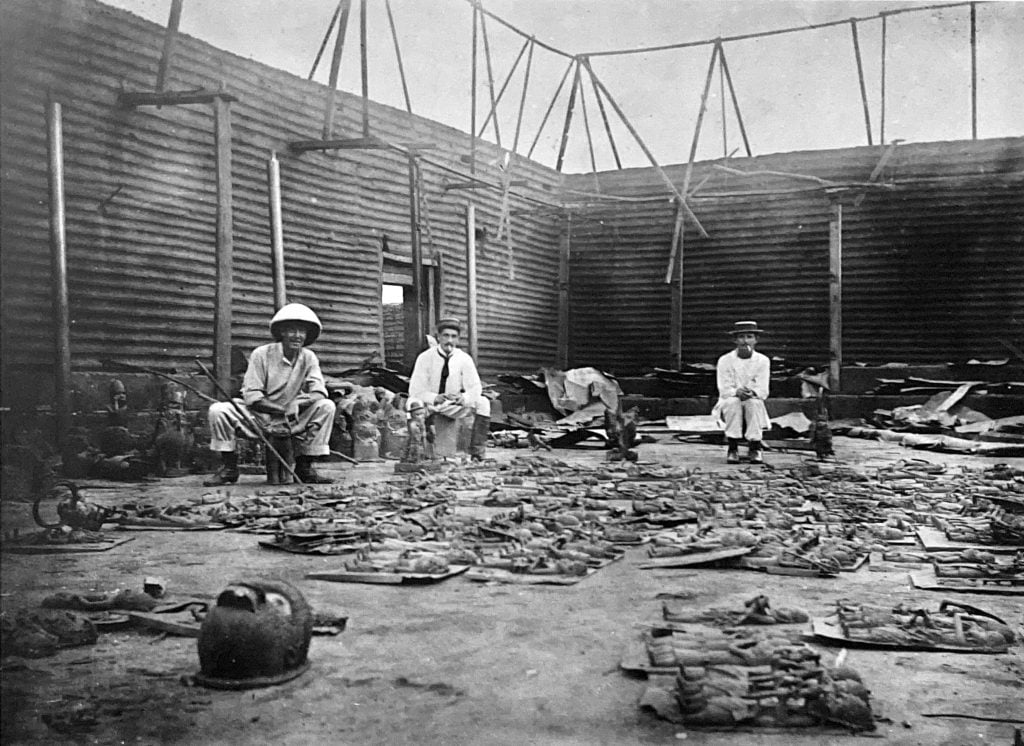
Interior of the Royal Palace during looting, showing Captain Charles Herbert Philip Carter (1864–1943), ‘E.P. Hill’ and an unnamed man, February 1897. Pitt Rivers Museum (accession number 1998.208.15.11).
Germany has made some leaps and bounds in regards to funding. They are now giving grants for provenance research to institutions. I’m curious what you think about the pace of Germany versus other nations?
MB: I just think we haven’t gathered over these issues in the way that Europe has. The Benin Dialogue Group has been meeting for about 10 years and has been discussing these matters, Germany included. We’re coming into this a little bit later, but we are beginning to form a consortium and we’re trying to work together because reaching out to communities is paramount. Talking to people like Victor and understanding what our responsibilities are and being collaborative is at the foundation of the work we’re doing.
The U.S. should take guidance from NAGPRA, the Native American Graves Protection and Repatriation Act, which has governed how American reckon with our colonialism and our history of domination of Native American peoples. There are two main lessons from that. One is inventories, knowing what you have. And the second is communication, collaboration, and respect.
DH: The work we just heard about so eloquently from Marla is at the heart of what restitution means. It starts with an acknowledgement of how much was taken and destroyed. Much of that was knowledge. What some call the decolonization of museums, I prefer to frame as the unfinished work of anti-colonialism and anti-racism. I think that’s fundamentally what we learned in the U.K. This means looking not only at the looting by 200 soldiers, sailors, and administrators who simply took what they wanted for their own gain, but looking at the art market and museums’ acquisition programs, which both worked for purposes of cultural supremacy.
A lot of the German debate is framed around the notion of being transparent. But transparency is one aspect only. Accountability is something else. When we heard the verdict after the trial related to the racist murder of George Floyd, there was an interesting moment where [U.S.] Attorney General Keith Ellison said he wouldn’t call it “justice, because justice implies true restoration. But it is accountability.” He said that accountability is a step towards justice. That is what this work is about in our museums.
Victor, there are all these different stakeholders in a complicated network to get these objects really moving. Can you speak a bit about the Legacy Restoration Trust’s work in that regard?
VE: I was invited to become part of it in 2020. This whole restitution debate has become part of the mandate for it, but the Legacy Restoration Trust is actually many things. We know how complicated this subject can be. The board members come from different angles—some are from history, from art, from finance. We try to be a central point of conversation for all the moving parts of this issue.
DH: What’s incredibly exciting for Europeans and Americans is that we are taking ourselves out of the conversation. We’ve been taking up space about returns for so long. There are different agents in Nigeria from the nation-state, to the governor to the Royal court—these conversations within Nigeria should be happening without neo-colonial interference. It’s wrong for us in the West to expect closure.
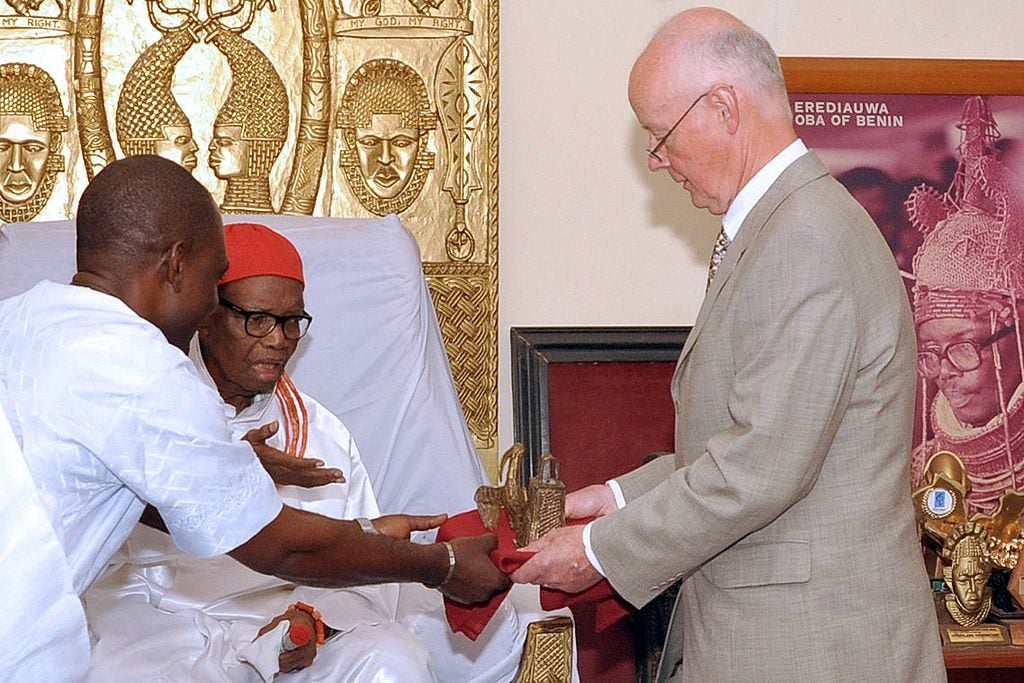
Retired hospital consultant Mark Walker (R) hands over two bronze artefacts he returned to the Benin kingdom to the Oba (King) of Benin, Uku Akpolokpolo Erediauwa I, during a ceremony in Benin City, Nigeria, on June 20, 2014. Photo: Kelvin Ikpea/AFP via Getty Images.
In the Sarr-Savoy restitution report, they said that if an object is stolen, it should be returned. In the case of Benin, as you said, Dan, the ransacking is well-documented. In Germany, in the case of Nazi-looted art, works have been returned when duress is proven. There are so many instances and situations where that would likely turn out to be true all across Africa. This should and will grow to become really big in scope.
MB: It’s a lifetime of work. We’ve talked about it at Fowler. We have objects that came from the Ashanti Wars in the early 1870s. We want to work directly with the Ashanti Palace in Kumasi. We need to know who to go to, but it’s complicated. There’s no other word for it, other than it’s complicated. We have objects from South Africa. To whom do we speak when we have objects that belong to villages or former kingdoms? It’s really such a difficult situation, but one in which we still profoundly want to make progress and want to do the right thing. From my point of view, it really is going to reshape the role of the curator, the importance of archival work, and the priorities of curatorial work.
Victor, I can imagine colleagues in neighboring countries are probably looking to adapt and create their own versions of the Legacy Restoration Trust.
VE: Colonization of Africa didn’t happen at once. Even though these are not new conversations, this is the first time we are having some traction. But if restitution is going to continue to work, we have to build a model. Like Marla said, it is going to be a lifetime of work. But it is starting. Martin Luther King was in the 1960s. Obama was in the 2000s. But you cannot, we could probably say, have had Obama without having King before. So the models that are being created right now are kind of like the pillars for futures. If other people see what is being done with the Benin Bronzes, and if we are successful, then there will be precedents to reference.
That could also be frightening to a lot of museums. “Where does it stop?” one might say. We have to do a balancing act. We’re doing it correctly when we’re addressing the provenance. We’re not asking for people to just give everything, as if a museum is being raided. This is not a revised punitive expedition. The objects you can trace must be addressed in a way that is beneficial to both parties.
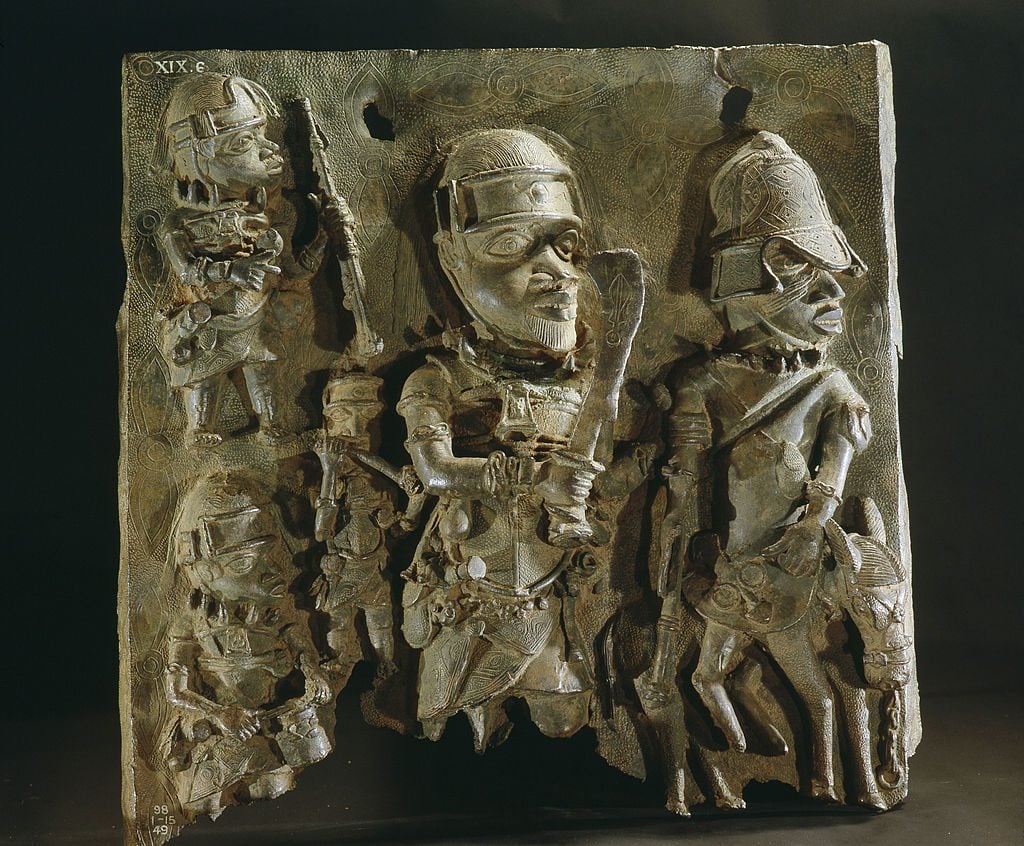
A plaque which decorated the palace of the Obas, Benin warriors are depicted in battle. Nigeria. Edo. Probably late 17th century. Benin City. (Photo by Werner Forman/Universal Images Group/Getty Images)
Speaking about different strategies, I wanted to bring up the activist Mwazulu Diyabanza, who has been actively removing objects from European museums. I wonder what your reaction is to his actions?
VE: There is no one cookie-cutter approach. If you look at colonialism, Belgium was different in their approach; Germany was different in their approach; France was different in their approach. People asking for restitution are going to have different approaches to it, too. At the same time, we have to bring humanity and civility to that conversation. How do we go about it lawfully, even though a lot done during colonialism was unlawful? You do not stamp out fire with fire.
DH: The Rhodes Must Fall protest was happening outside the [Pitt Rivers] museum. When your audience comes to your front door and protests your institution, you have to try and understand. I think Diyabanza’s interventions were designed to expose the question about legitimacy. The French culture minister said the objects in French museums are inalienable. Well, they were also inalienable to the oba of Benin. So whose system of justice is right? Who is the thief? Who is the criminal?
I don’t know the details of these interventions or whether laws were broken, but what I know is that, as a performance art intervention, it seems to me that it is a rightful challenge to the legitimacy of the museum, especially when it presents itself as under attack.
What about private collections? The number of works in private collections is totally unknown.
MB: Museums can educate their audiences and work with collectors so that they understand the issues in a dispassionate way. Ownership is not static. They need to think about how they personally are obligated to contend with problematic histories of these objects they own. It’s up to museums to educate not by sitting them down and saying, over drinks, “You really need to think about your collection,” but by doing exhibitions, public programming, and really trying to frame these arguments to the fullest degree that we can. There are collectors who are doing the right thing. But some are caught up in the investments they made to buy these objects. That’s part of what’s going on in their minds. I think they have to be led to go beyond that, and to think about what’s right.
VE: Auction houses have a lot of work to do, too. They need to turn some of these objects down. They keep coming up for sale and auction houses keep selling them. Dealers have work to do too, because they deal in these objects. I would even exonerate the museums from this specific conversation, because it is really the dealers and the auction houses who know where objects might be, and who have the responsibility.
DH: There was an interesting piece in the Financial Times last weekend, which I appeared in, that talked about the changing questions over the value of the looted Benin art. There are questions of the saleability of these items. In many cases, maybe half the cases, we are looking at objects where people made an investment, but maybe half of what’s out there has been inherited. These are the descendants of those who took it. In those cases, we are seeing returns. We’re seeing exactly what we see in museums: not a legal process but rather a coalition of the willing. That phrase is from a different and rather horrendous context of the Iraq War… But maybe we can reuse and reclaim it to describe how many are acting today.
MB: In the case of Albright-Knox Art Gallery, in 2007, the museum decided to deaccession a Benin bronze head at auction for almost $5 million to use that money to buy other art. It raises really thorny issues about the fact that that institution gained that resource from that one piece that was stolen. They didn’t even own it in the first place. Auction houses are now becoming very reluctant to get into the middle of what is, in fact, an illegal transaction.
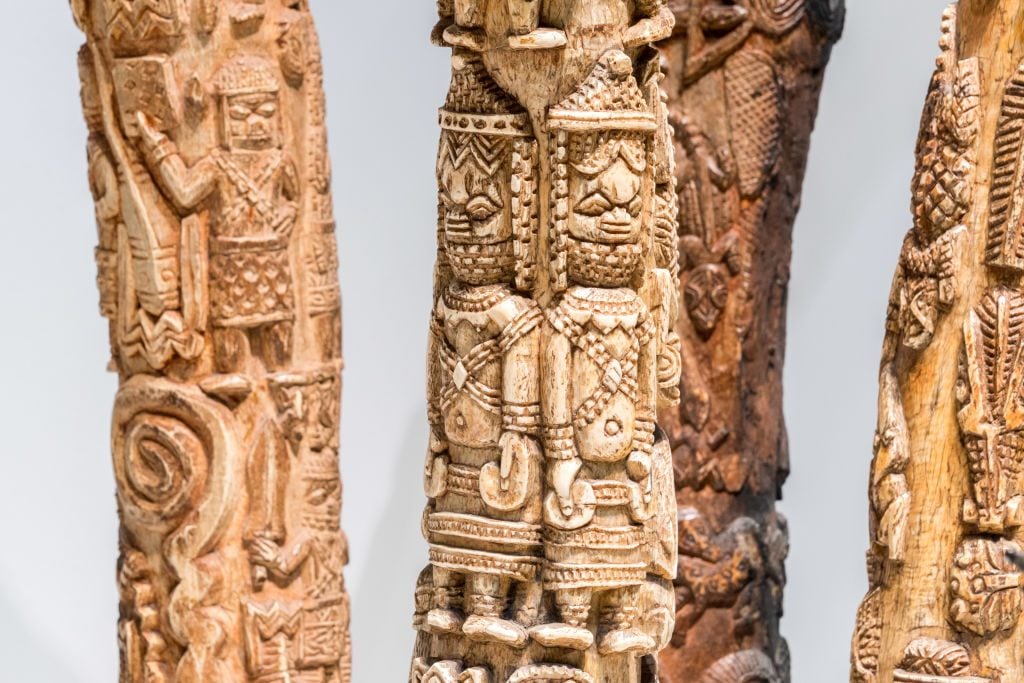
Carved elephant tusks looted by British soldiers from the Kingdom of Benin in 1897 are displayed in the “Where Is Africa” exhibition at the Linden Museum on May 05, 2021 in Stuttgart, Germany. Photo: Thomas Niedermueller/Getty Images.
Hopefully it doesn’t drive it underground, though, because there’s a growth of these private sales at auction houses.
MB: But when you find out, there’s the shaming aspect. People put it right into the press and that helps, actually.
DH: I don’t think we can imagine a European or American Museum actively purchasing a looted Benin artwork now. We have passed that point. Some wonder whether, when the Aberdeen object is returned to Nigeria, the British government will attempt to intervene and force a sale within the U.K. I don’t think the British Museum or any U.K. institution is going to take that Aberdeen object at this point, though. I think we are seeing a sentiment change in a very interesting way. These are no longer being understood as just “assets.” They’re royal, sacred, stolen objects.
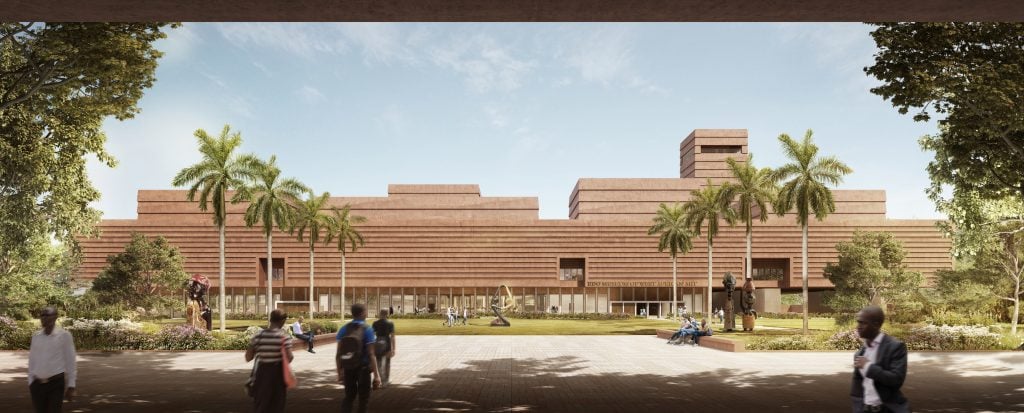
View of main entrance and courtyard garden of the Edo Museum of West African Art (EMOWAA) in Benin City, Nigeria. © Adjaye Associates.
What is one of your hopes for the next steps in this debate?
VE: Museums shouldn’t be afraid to return works that are problematic. If you can trace the provenance to the fact that it was looted, a lot of them should do the right thing and figure out a way to return them to their original owners. They can always acquire new artworks to continue that history.
MB: What the museum field needs are resources to do this work. I would like to advocate for philanthropy turning its attention to helping curators at institutions that are committed to knowing more about their collections. We are not just taking on the high-profile cases like the Benin Bronzes. We must address all the other material we have that we need to know more about. Institutions need multi-year grants, they need to cover staff time, travel, all the ways that we need to further the work. It’s never good to say, “We can’t do this, because we don’t have the money.” We have to find the money. We have to make the persuasive arguments. We have to make these issues public. So bravo to those who support the work, and let’s find more foundations who can do this in the future.
DH: One of the real challenges for us is to be able to lower our standards of evidence. The men in the expedition took photographs and documented and wrote down everything. You couldn’t ask for more accuracy. In other cases, there won’t be that level of documentation, but that doesn’t mean the case for return isn’t any less compelling. That’s the challenge for us as we do the provenance research. We have to make sure that all these other historical incidents do not get brushed under the carpet.
